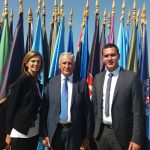For many onlookers to the Croatian Homeland War, there was a simple story arc: the clumsy arrogant west came into the Yugoslavian conflict and armed one side and punished another, siding with Croatia to expel 200,000 Serbian civilians from their homes in Krajina. As with everything, particularly in war, there is much more to it than meets the eye.
War paints a very different picture; one of compromise and support for Serbian claims to Krajina counterbalanced with the Croatian need for territorial integrity. Due to Serbian arrogance, Croatia was forced into action, which resulted in operations Flash and Storm.
The Z4 Plan
The Z4 Treaty was created by American senator Peter Galibraith to end the escalation of conflict in the Homeland War in Croatia. It was called the Z4 treaty because it was proposed in Zagreb, and had four major international entities involved: The EU, The UN, The USA and Russia.
The initial Z4 plan proposed in early 1994 envisioned Croatia being partitioned into two separate and distinct entities, the Serbian Republic of Krajina and the Croatian Republic. While federally considered one country, the Serbian entity would have freedom to make its own international agreements, trade, have its own currency, police force, flag and parliament. The Serbian Republic of Krajina would be delineated according to the 1991 Croatian census, in eleven districts where Serbians were an absolute majority.
The diplomats involved wanted to fairly represent areas where Serbians were a majority, give back land to Croatians from which they were expelled, and reintegrate eastern Slavonia to Croatia which was being occupied.
Presidents’ Reactions
The plan was first shown to the presidents of Serbia, Krajina and Croatia in late 1994, and the final draft of the fifty-three- page document was shown in early 1995. The initial reactions of Tuđman was reluctant acquiescence, he obviously wanted to have a free Croatia under the auspices of western approval and did not want to escalate the conflict if it wasn’t necessary. Even though a major military action was in planning stages, Tuđman was trying to balance the perception of Croatia as a mature country ready to lead, respect human rights and become closer to the west with the need for the Croatian state to reassert its control over its borders. One cannot claim that Tudman was operating in bad faith either, as there would be very little wiggle room to back out after saying yes, especially if the Serbian side agreed to Z4.
Even though Tuđman reluctantly agreed to what would be a domestic political career-ender. The Serbian contingent, Babić and Milošević refused; Milosevic and Babić both thought that Krajina was militarily unassailable, and had the political protection of Belgrade. On the 8 th of February 1995, the Serbian parliament of Krajina formally rejected the Z4 plan and halted all future negotiations with the western contingent, wanting the UN to guarantee protection for Krajina with its peacekeeping force to be the basis for future negotiations.
The Last Chance
Knowing that a Croatian offensive was soon to commence, Milosevic requested foreign diplomats of the Z4 plan to come to Belgrade to discuss terms on the 31 st of July. Diplomats advised Milosevic that Babić would need to accept agreements based on the Z4 plan in order to avoid hostilities and a Croatian military offensive. On the 3 rd of August 1995, Croatian and Serbian delegations met, this time Croatia dictated the terms of the agreement, bolstered by their recent military victory of Operation Flash and the liberation of Western Slavonia, Tuđman proposed a seven-point plan which was highlighted by the following: the replacement of the Serbian government with a Croatian civilian government effective immediately, integration of Krajina back into Croatia, and limited local autonomy for Serbians in the region.
Tudman knew Serbian diplomatic perception was at an all-time low- due to the Krajina Serb military involvement in the siege of Bihać- and his offer reflected the strong position the Croatian side knew it was in. Serbian authorities cancelled the negotiations, refusing to negotiate with the Croatian side, believing Tuđman’s offer to be heavy handed and that Krajina was militarily defensible. By the end of Operation Storm, Krajina had been defeated and political leaders were banished to exile, on the 16 th of August, Babić contacted the foreign delegation to restart Z4 plan talks, foreign diplomats considered all negotiations null and void, with Croatia having won the war and effectively reasserted its territorial integrity. Croatian delegates indicated their refusal to negotiate after the battle was won.
Aftermath: The Lessons
The history of the Z4 plan reveals the subtle nature of the Homeland War, far from what most onlookers believed to have happened. The plan represented the desire of the west to avoid war and destruction and compromise with both sides to reach an accommodation. Tuđman accepted and Milošević declined, and the diplomatic tides slowly turned. It was a combination of arrogance and disrespect for the process of diplomacy which undid Serbian Krajina, and Operation Storm was as much to blame on the government of Krajina and Milošević as it is on the usual suspects.










